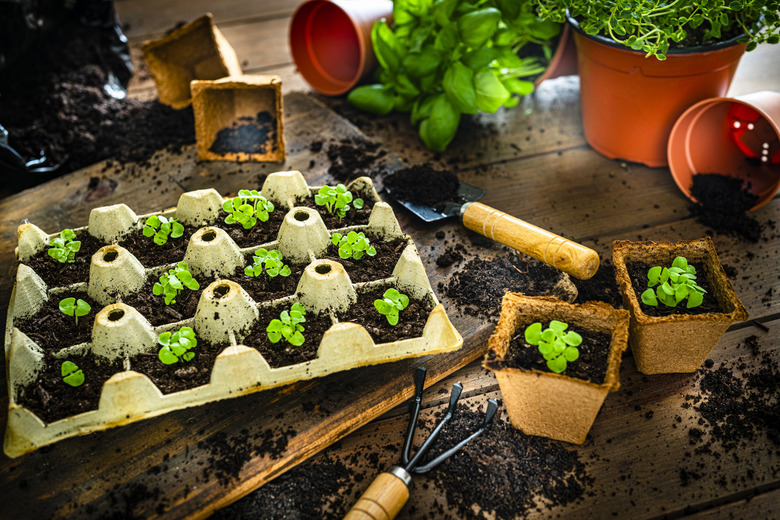How To Recycle Styrofoam Egg Cartons
We may receive a commission on purchases made from links.
When you're shopping for eggs, you're probably thinking about prices and recipes and not the material from which the carton is made. Material matters when the eggs are gone, and it's time to dispose of the empty carton. Cardboard egg cartons seem straightforward; they're made of pulped paper fibers just like other cardboard and can generally (though not always) be recycled along with your other used cardboard. Styrofoam, however, trips people up. Should your foam egg cartons go in the curbside bin, and are Styrofoam egg cartons recyclable at all?
Are Styrofoam Egg Cartons Recyclable?
Are Styrofoam Egg Cartons Recyclable?
To understand the challenges with Styrofoam recycling, it's useful to understand how this material is made. What we commonly think of as Styrofoam packaging, like the stuff that's used to make packing peanuts and disposable cups, is technically called expanded polystyrene foam, or EPS. The foam is made by heating and expanding tiny balls of plastic resin and pressing the heated resin into shapes using molds. This process yields a sturdy yet lightweight product that traps heat well, which is why Styrofoam's common uses include packaging hot foods and home insulation.
One big problem with Styrofoam is that it's not easily recycled compared to other materials. Used cardboard can be broken down into reusable paper fibers and made into new paper products. Metal can be melted down and reused over and over again. Styrofoam can also be melted down, creating recycled resin that can be used to make products like picture frames and crown molding, but this is a specialized kind of recycling, and most facilities don't have the ability to process Styrofoam along with other common recyclables.
In short: Are Styrofoam egg cartons recyclable? Technically, yes, but realistically, not usually.
Disposing of Styrofoam Egg Cartons
Disposing of Styrofoam Egg Cartons
Because there's not a cost-effective way for them to manage old Styrofoam, recyclers generally don't want it. Most municipalities tell residents to dispose of Styrofoam along with their regular trash. It's worth verifying this with your municipality's waste disposal agency because some communities do have access to foam recycling services. You might need to drop off your clean foam egg cartons at a designated facility rather than put them in your curbside recycling bin.
Some grocery stores offer take-back programs for foam food packaging, which might be an option in your area. Also check with the brand that produced the eggs. For one, Eggland's Best takes back foam cartons from its eggs. However, you'll have to pay for your own postage and weigh the environmental cost of shipping a box of foam cartons to Indiana so they can (hopefully) be recycled versus putting them in your trash.
Reusing Styrofoam Egg Cartons
Reusing Styrofoam Egg Cartons
Styrofoam isn't biodegradable, and it takes up a ton of space in landfills. So, people who are concerned about sustainability might want to use and reuse their foam egg cartons before trashing them to get as much value out of each one as possible. You might see foam egg cartons used to organize beads or hold paint for kids' art projects. These are creative ways to reuse egg cartons, but because egg cartons can be contaminated with bacteria, they should be considered one-use products.
Out of an abundance of caution, you might not want to have kids use foam cartons for their projects, but if you're comfortable handling them yourself, egg cartons make perfect trays in which to start seedlings. This is a quick and easy project that's perfect for beginning gardeners. Hopefully, your seeds will sprout, and you can transfer them to larger containers. If not, you won't have wasted much time or money.
Wash and dry the egg carton and then poke a few small holes in the bottom of each cup for drainage. Fill the cups halfway with potting soil, add seeds to each one, and cover them completely with soil. Put them in a sunny place and spritz the seeds with water each day. Many types of flower seeds and herb seeds can be sprouted this way but think about a big-picture plan for your future plants when making seed choices. For example, apartment dwellers might want to plant several herbs that can be potted together to maximize limited space.
References
- Earth911: Recycling Mystery: Expanded Polystyrene
- County Waste & Recycling: Egg Cartons – Recycle or Reuse or Trash
- City of Malden, Massachusetts: Trash & Recycling
- U.S. Department of Agriculture: Could Cross Contamination Occur When Packaging Materials Are Reused?
- Eggland's Best: Eggland's Best Packaging
- Earth911: Debate Over Expanded Polystyrene Recycling Gets Weighty
